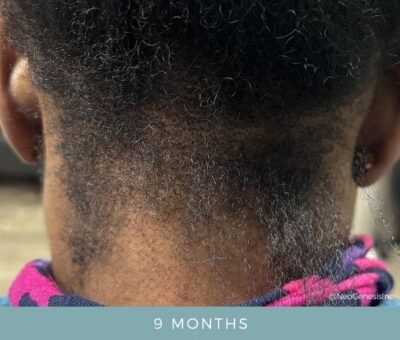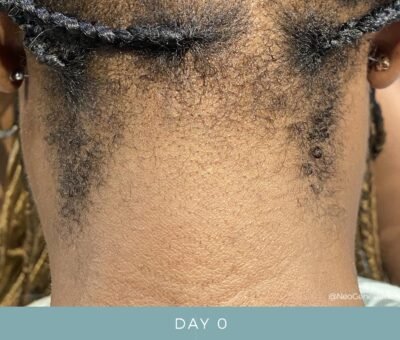Traction alopecia is a form of hair loss that occurs when hair follicles are damaged by constant tension or pulling. While preventable, it often goes unaddressed until visible damage has taken place, making early awareness and action crucial. This blog explores the science behind traction alopecia, the emotional impact of hair loss, and how growth factors like NeoGenesis Hair Thickening Serum may contribute to treatment and recovery. We’ll also share insights from expert trichologist Sophia Emmanuel to emphasize the importance of scalp care and education.
The Science Behind Traction Alopecia
Traction alopecia is the result of hair being pulled too tightly over time. Common culprits include hairstyles like tight braids, buns, ponytails, and the use of hair extensions. According to Sophia Emmanuel, owner of Crown Worthy Trichology, traction alopecia often occurs along the front and back hairlines but can develop in other scalp areas as well. Persistent tension can inflame hair follicles, leading to scarring. Once this scarring occurs, active hair follicles may stop functioning, making regrowth much harder—or even impossible.
Hair relaxers and other chemical treatments can exacerbate the problem, as these products may weaken the hair shaft and scalp, making them more vulnerable to damage. However, traction alopecia differs from other forms of hair loss in one critical way—it is largely preventable with proper education and care.
 Addressing the Emotional Impact of Hair Loss
Addressing the Emotional Impact of Hair Loss
Hair is often closely tied to identity, and for many, its loss has a significant psychological impact. “A lot of times what ends up happening is that people suffer in silence,” Sophia explains. “They may not speak about it. Or when they go to the doctor, the doctor may not even identify it as something important.” This void of understanding can leave people feeling isolated, as hair loss is commonly perceived as a cosmetic issue rather than a concern tied to self-esteem and mental wellbeing.
For individuals navigating hair loss, acknowledging the problem and seeking support is a critical first step. “Sometimes the hardest part can be willing to address that there’s a problem,” adds Sophia. “Once you’re ready to do that, then the next step is to find the necessary specialist that’s gonna be able to help you figure it out.”
Prevention is Key
Given its preventable nature, educating people about safe hair practices is essential. Traction alopecia is especially relevant in communities where protective styles like braids and locks are part of cultural identity. However, when these styles are overused or done improperly, they can lead to damage. Sophia points out, “At the end of the day, as Black people, braids and locks and these different types of hairstyles are part of our culture, part of our identity. But when they’re overused, problems can develop. It’s important to help people navigate through that—how they can wear it, but how to do it safely.”
 Here are a few tips to reduce the likelihood of traction alopecia:
Here are a few tips to reduce the likelihood of traction alopecia:
- Avoid tight hairstyles, especially for prolonged periods. If you feel pain or scalp tension, consider loosening the style.
- Limit the use of chemical treatments, such as relaxers, that can weaken both the scalp and hair.
- Rotate hairstyles to give hair follicles a break.
- Moisturize and nourish the scalp regularly to maintain a healthy foundation for hair growth.
The Potential of Growth Factors in Treatment
If traction alopecia is diagnosed early, there are hope and options for restoring both hair and confidence. One emerging area of treatment involves the use of growth factors, which are natural proteins that stimulate cell activity. Products like NeoGenesis Hair Thickening Serum leverage these advanced growth factors to improve scalp health, stimulate dormant follicles, and encourage regrowth where possible.
By reducing irritation, promoting blood circulation, and providing essential nutrients to the scalp, the serum helps create an environment where hair follicles can thrive. For those who still have active follicles, this can be an important part of slowing further hair loss and potentially reversing early stages of traction alopecia.
The Role of Scalp Care and Professional Guidance
Proper scalp care is an essential component of both prevention and treatment. A healthy scalp is the foundation for hair growth. However, it’s important to recognize when professional help is needed. Case studies aid in understanding that there’s no one-size-fits-all solution. “Case studies allow us to show that hair loss can happen for several different reasons,” Sophia shares. “And some alternative treatments are out there that you can use to try and keep your hair and scalp healthy.”
Seeking guidance from a trichologist or similar specialist can provide customized recommendations to address specific causes of hair loss. These professionals educate clients on safe practices and scientifically backed treatments, emphasizing prevention as a fundamental strategy.
Final Thoughts
Traction alopecia serves as a reminder of the delicate balance needed between cultural practices, personal choice, and long-term health. By making informed decisions, educating ourselves on proper scalp care, and seeking early intervention when needed, we can significantly reduce the risk of irreversible hair loss.
For those already experiencing symptoms, treatments such as NeoGenesis Hair Thickening Serum offer promising advancements to improve outcomes. Most importantly, recognizing the emotional toll of hair loss and seeking support can make all the difference in restoring both confidence and well-being.






